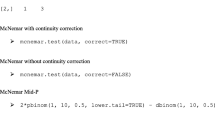Summary
Formulas are presented to illustrate the calculation of correct variances of prediction error (PEV) and the correlation between true and predicted values (rTI) when the incorrect variance-covariance matrix for the random effects is used in mixed-model equations (MME). The example with progeny records of highly related and inbred sires showed that PEV were underestimated from the diagonals of the inverse of the coefficient matrix of the MME when sires were assumed unrelated and not inbred and were overestimated when relationships among sires were calculated with Henderson's simple rules for the inverse of the numerator relationship matrix, A-1, which do not consider inbreeding. When Quaas' rules for A-1, which do consider inbreeding, are used, the correct PEV are obtained. In the example, calculations of rTI from the diagonals of the inverse of the coefficient matrix were too large when relationships and inbreeding were ignored and were obviously wrong when the approximation to the numerator relationship matrix, A, was based on the simple rules for calculating A-1. If the correct A is used in the MME, the calculation of rTI may be incorrect if inbreeding of the evaluated individual is not considered. If inbreeding is known, adjustment for inbreeding is easy for calculation of rTI.
Similar content being viewed by others
References
Golden BL, Brinks JS, Bourdon RM (1991) A performance-programmed method for computing inbreeding coefficients from large data sets for use in mixed-model analyses. J Anim Sci 69:3564–3573
Henderson CR (1975a) Comparison of alternative sire evaluation methods. J Anim Sci 41:760–770
Henderson CR (1975b) Best linear unbiased estimation and prediction under a selection model. Biometrics 31:423–447
Henderson CR (1976) A simple method for computing the inverse of a numerator relationship matrix used in prediction of breeding values. Biometrics 32:69–83
Henderson CR (1977) Best linear unbiased prediction of breeding values not in the model for records. J Dairy Sci 60:783–787
Henderson CR (1984) Applications of linear models in animal breeding. University of Guelph, Ontario, Canada
Quaas RL (1976) Computing the diagonal elements and inverse of a large numerator relationship matrix. Biometrics 32:949
Van Vleck LD (1988) Notes on the theory and application of selection principles for the genetic improvement of animals. Cornell University, Ithaca, N.Y., USA
Author information
Authors and Affiliations
Additional information
Published as paper no. 9947, Journal Ser, Nebraska Agric Res Div, University of Nebraska, Lincoln, Neb.
Rights and permissions
About this article
Cite this article
Van Vleck, L.D. Variance of prediction error with mixed model equations when relationships are ignored. Theoret. Appl. Genetics 85, 545–549 (1993). https://doi.org/10.1007/BF00220912
Received:
Accepted:
Issue Date:
DOI: https://doi.org/10.1007/BF00220912




